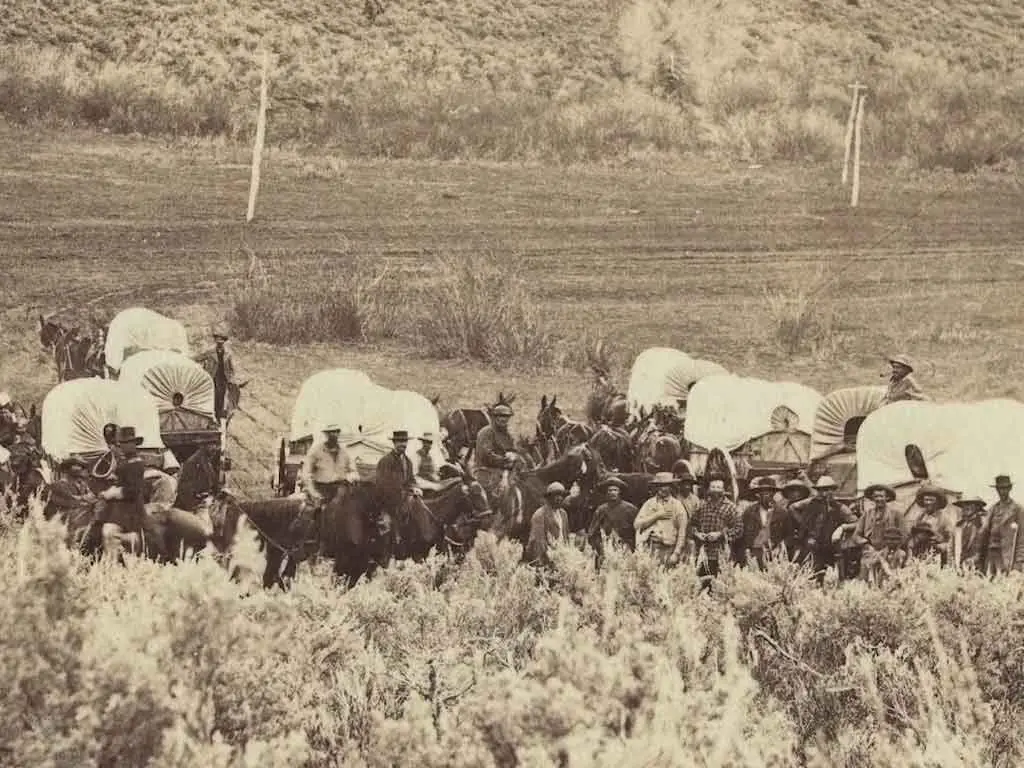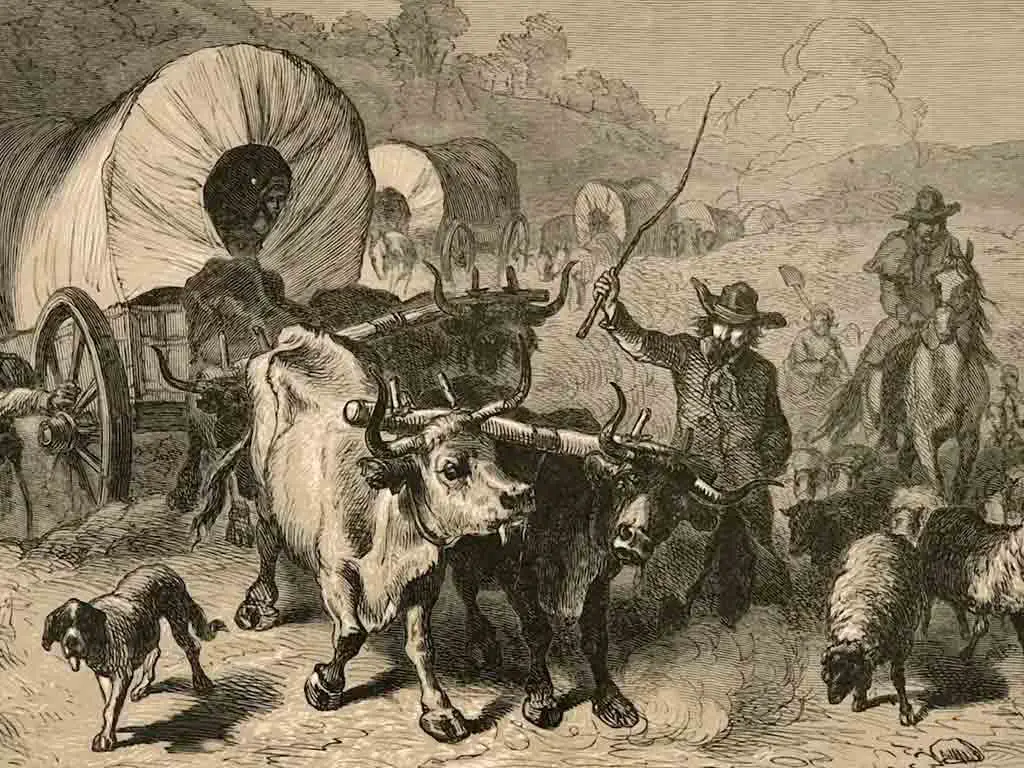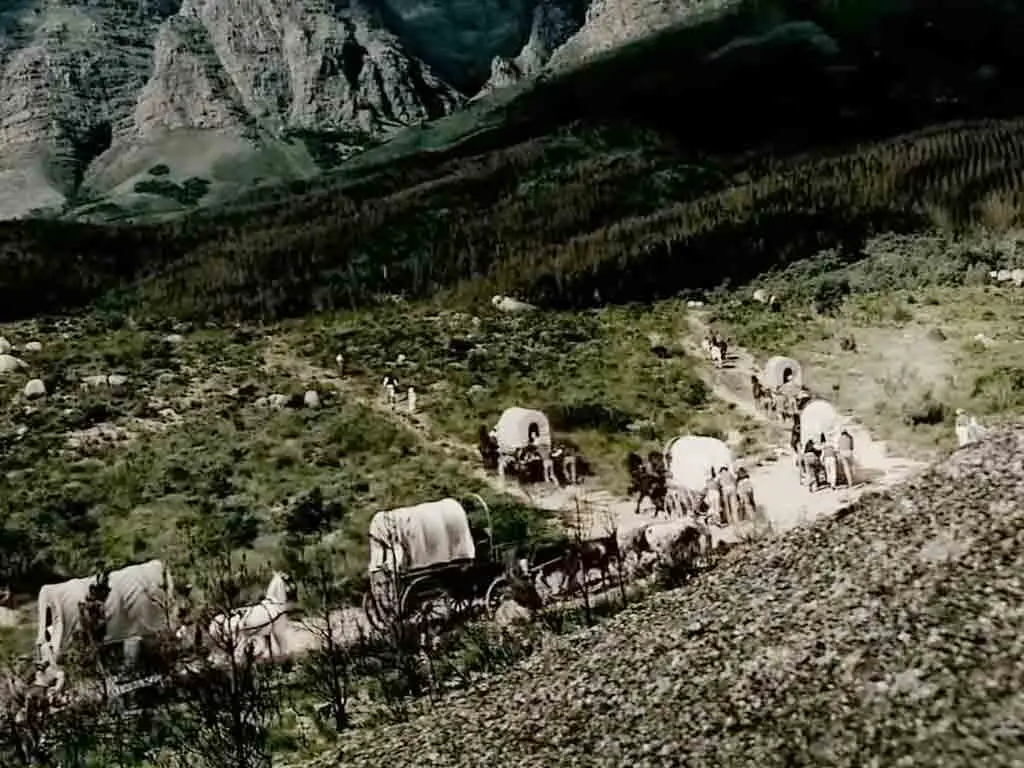The westward migration along the Oregon Trail in the mid-19th century was a perilous journey fraught with challenges that tested the mettle of American pioneers.
The survival rate on the Oregon Trail, a 2,000-mile route, hovered around 90%, indicating that approximately one in ten emigrants did not complete the arduous trek successfully.
Disease, particularly the dreaded cholera, posed a significant threat, as did accidents such as wagon mishaps and drownings during river crossings.
Harsh environmental conditions, exposure to the elements, and occasional conflicts with Native American tribes further contributed to the mortality rate.
Despite these formidable obstacles, the Oregon Trail played a vital role in the westward expansion of the United States, leaving an indelible mark on American history.

What Was the Oregon Trail Survival Rate?
The Oregon Trail was a 2,000-mile route that thousands of American pioneers used to migrate west in the mid-1800s.
However, the journey was not without risks and hardships. About 10% of the emigrants who traveled on the Oregon Trail died along the way.
The main causes of death were disease and accidents. The most feared disease was cholera, which could kill a person within hours of infection.
Accidents included drowning, snake bites, wagon accidents, gunshots, and stampedes.
Some emigrants also faced attacks from Native Americans, especially after the Whitman Massacre of 1847.
Despite the dangers, the Oregon Trail was a vital route for the expansion of the United States and the settlement of the Oregon Territory.
How Many People Died on the Oregon Trail?

Between 20,000 and 30,000 people died on the Oregon Trail, which means that approximately 1 in 10 emigrants did not survive the journey.
The majority of deaths occurred due to diseases caused by poor sanitation, with cholera and typhoid fever being the biggest killers.
Other causes of death included accidents, such as wagon accidents, accidental gunshots, and drownings during river crossings.
There were also conflicts between Native Americans and emigrants, with Native Americans killing 362 emigrants and emigrants killing 426 Indians between 1840 and 1860.
How Many People Survived the Oregon Trail?
Between 70% and 96% of the emigrants who set off on the Oregon Trail survived the journey.
The number of people who survived the trail is difficult to determine with certainty, but it is generally agreed that between 20,000 and 30,000 people died on the trail.
The majority of deaths occurred due to diseases caused by poor sanitation, with cholera and typhoid fever being the biggest killers.
Other causes of death included accidents, such as wagon accidents, accidental gunshots, and drownings during river crossings.
There were also conflicts between Native Americans and emigrants, with Native Americans killing 362 emigrants and emigrants killing 426 Indians between 1840 and 1860.
What Factors Contributed to Mortality Rate on the Oregon Trail?

Several factors contributed to the mortality rate on the Oregon Trail, making the westward migration a perilous journey for many pioneers in the mid-19th century.
These are the factors that contribute to the Oregon Trail death rate:
Disease
- Cholera: Cholera was one of the most significant and feared diseases on the Oregon Trail. The lack of sanitation, contaminated water sources, and close quarters in wagon trains facilitated the rapid spread of the disease. Cholera could lead to severe dehydration and death within hours.
- Dysentery and Other Illnesses: In addition to cholera, pioneers were susceptible to dysentery, smallpox, and other infectious diseases. The proximity of large groups of people in confined spaces made it challenging to prevent the spread of illnesses.
Accidents
- Wagon Accidents: Traveling over rough terrain and crossing rivers posed substantial risks. Wagon accidents, such as overturns or malfunctions, could result in injuries or fatalities.
- Drowning: River crossings were particularly dangerous. Wagons and livestock sometimes had to be ferried across rivers, and accidents during these crossings could lead to drownings.
- Snake Bites: The unfamiliar environment along the trail exposed pioneers to various wildlife, including venomous snakes. Snake bites were a real threat, and without prompt medical attention, they could be fatal.
- Gunshots: Accidental discharges of firearms, especially in the close quarters of wagon trains, could lead to injuries or deaths.
- Stampedes: Livestock, such as oxen and cattle, were essential for transportation and supplies. However, stampedes could occur, posing a danger to both animals and humans.
Exposure and Harsh Conditions
- Weather Extremes: Pioneers faced extreme weather conditions, including scorching heat, freezing temperatures, and storms. Exposure to the elements increases the risk of hypothermia, heatstroke, and other weather-related illnesses.
- Malnutrition: Limited food supplies and the reliance on non-perishable goods meant that pioneers often faced malnutrition, weakening their immune systems and overall health.
Native American Conflicts
- Tensions and Attacks: While not as common as other challenges, some pioneers faced conflicts with Native American tribes along the trail. The tensions escalated, particularly after events like the Whitman Massacre in 1847, leading to occasional skirmishes and attacks.
Lack of Medical Facilities
- Limited Access to Medical Care: The remote nature of the trail meant that pioneers had limited access to medical facilities and professional healthcare. Injuries and illnesses had to be addressed with basic supplies and often home remedies.
Why Is the Oregon Trail Considered a Vital Route Despite Its Risks?

The Oregon Trail is considered a vital route in American history despite its inherent risks due to its pivotal role in the westward expansion of the United States.
Several factors contribute to its significance:
Manifest Destiny and Westward Expansion
The mid-19th century was characterized by the fervent belief in Manifest Destiny, the conviction that the United States was destined to expand its territory from coast to coast.
The Oregon Trail, spanning over 2,000 miles, played a crucial role in fulfilling this vision by providing a practical route for pioneers to venture into the uncharted West.
This westward expansion was seen as a means to fulfill national destiny and secure the economic and social future of the burgeoning nation.
Economic Opportunities
The allure of economic prosperity and fertile lands motivated pioneers to undertake the arduous journey along the Oregon Trail.
The promise of abundant natural resources and agricultural potential in the Oregon Territory fueled dreams of a better life and attracted individuals seeking economic opportunities beyond the established eastern regions.
The trail, in essence, became a pathway to economic advancement and a chance for individuals and families to secure a more prosperous future.
Population Growth and Homesteading
The Oregon Trail became a corridor for population growth in the West. The passage of the Homestead Act in 1862, offering free land to settlers willing to cultivate and improve it, encouraged homesteading along the trail.
Families and individuals sought to claim their stake in the West, contributing to the demographic expansion of the nation.
The establishment of homesteads along the trail laid the groundwork for the growth of communities and the settlement of new territories.
Expansion of Trade and Commerce
As pioneers traversed the Oregon Trail, they inadvertently became agents of economic expansion.
The trail facilitated trade between the developing western territories and the more established eastern regions, fostering the growth of commerce and contributing to the overall economic integration of the nation.
The movement of goods, people, and ideas along the trail played a vital role in connecting the disparate parts of the country.
Cultural and Social Impact
The Oregon Trail left an indelible mark on the cultural and social identity of the United States.
Stories of resilience, determination, and survival along the trail became part of the American narrative.
The pioneering spirit embodied by those who faced the challenges of the journey contributed to the nation’s ethos and identity.
The shared experiences of the trail forged a sense of unity and common purpose among diverse groups of pioneers.
Formation of New Communities
Along the Oregon Trail, pioneers established settlements and communities that would evolve into towns and cities.
The trail played a fundamental role in shaping the demographic landscape of the West, laying the foundation for the development of new states and territories.
These communities represented the seeds of civilization planted in the vast wilderness, marking the westward march of American society.
Legacy of Exploration
The Oregon Trail symbolizes the spirit of exploration and adventure that defined the era of westward expansion.
Pioneers braved the unknown, overcoming formidable challenges and hardships. Their journey left a lasting legacy, inspiring future generations and contributing to the national narrative of exploration and expansion in the American West.
The lessons learned and the indomitable spirit of those who embarked on the trail continues to resonate in the American consciousness, shaping perceptions of perseverance and opportunity.
FAQs
What were the main causes of mortality on the Oregon Trail?
Disease, particularly cholera, accidents such as wagon mishaps and drownings, exposure to harsh conditions, and occasional conflicts with Native American tribes were among the main causes of mortality on the Oregon Trail.
How did disease contribute to the mortality rate on the Oregon Trail?
Diseases like cholera spread rapidly due to unsanitary conditions and contaminated water sources, posing a significant threat to pioneers and contributing to the mortality rate.
Were there conflicts with Native Americans along the Oregon Trail?
Yes, tensions and occasional conflicts with Native American tribes occurred, especially after events like the Whitman Massacre of 1847, adding to the challenges faced by pioneers.
Why is the Oregon Trail considered a vital route despite its risks?
The Oregon Trail played a crucial role in the westward expansion of the United States, despite its risks, as it provided a route for pioneers seeking new opportunities and settlements in the Oregon Territory.
To Recap
The survival rate on the Oregon Trail underscores the resilience and determination of the mid-19th-century pioneers who embarked on this transformative journey.
Despite facing the grim realities of disease, accidents, harsh conditions, and occasional conflicts, approximately 90% of emigrants persevered in their quest for a new life in the West.
The sacrifices made along the 2,000-mile trail, where lives were lost to cholera, accidents, and other challenges, are a testament to the indomitable spirit of those who sought opportunity and adventure.
The Oregon Trail remains a poignant chapter in American history, symbolizing both the hardships endured and the enduring legacy of westward expansion in the pursuit of a better future.

Your comment is awaiting moderation.
Устали от скучных стен? Пора преобразить свою квартиру с помощью ошеломляющих самоклеящихся пленок от Walls Decor! Эти волшебные отделки подарят вашему интерьеру шикарный вид, будь то офис или уютное обитель.
Погрузитесь в обширный мир узоров и потрясающих оттенков. Реализуйте самые смелые дизайнерские замыслы без сложного ремонта! Несложность нанесения и долговечность пленок Walls Decor обеспечат скорый и превосходный результат.
Откройте мир безграничной красоты!
Самоклейка в ванную – https://walls-decor.com.ua/samokleyushchayasya-plenka
Позвольте самоклеющимся пленкам стать вашими спутниками в формировании поистине модного и неповторимого оформления!